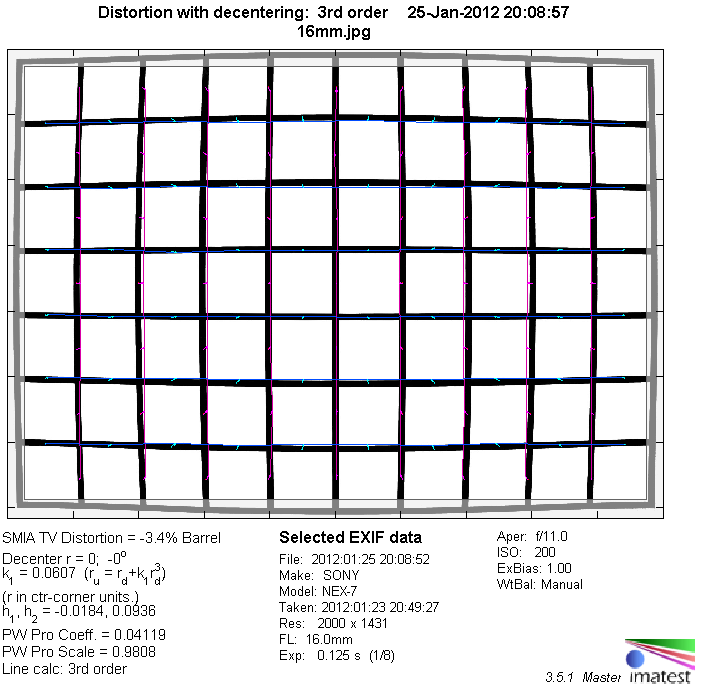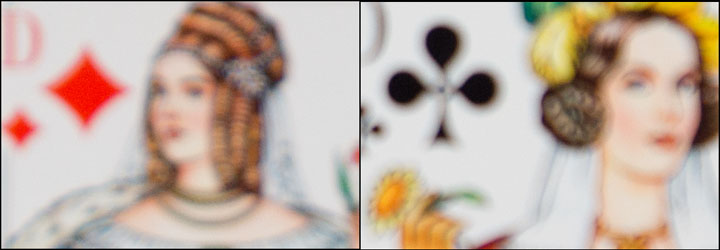|
Sony 16-50mm f/2.8 DT SSM (SAL-1650) - Review / Lens Test - Analysis |
|
Lens Reviews -
Sony NEX
|
|
Page 2 of 3

Distortion
The 16-50mm DT shows the typical distortion characteristic of a standard zoom lens. At 16mm you will have to live with a rather heavy amount of barrel distortion (3.4%) whereas the issue is basically negligible in the middle part of the zoom range before increasing again to slight pincushion distortion at 50mm.
|
Move the mouse cursor over the focal length text marks below to observe the respective distortion
|
| 16mm |
24mm |
35mm |
50mm |

|
Vignetting
The light falloff at large apertures is quite pronounced. This is especially true for 16mm @ f/2.8 (1.9EV) and it makes sense to stop down to at least f/5.6 to tame the issue to an acceptable degree. At 24-50mm it is sufficient to choose f/4 to leave the worst light falloff behind. The difficult characteristic of Sony's 24 megapixel sensor has probably a fair share in this issue.

MTF (resolution)
Even the Sony 16-50mm f/2.8 DT SSM struggles a bit with the NEX 7 sensor but it does a better job than most lenses that we've tested so far here. The center quality is pretty much flawless at 16mm. The border quality is already good at f/2.8 and it even reaches very good figures at medium aperture settings. The extreme corners are slightly soft at max. aperture but very decent at mainstream settings. The 24mm focal length is the sweet spot of the lens with an excellent center and a good to very good outer image region. At 35mm there's a bit of a performance penalty at f/2.8 again but the quality is fine at f/4 and pretty good at f/5.6. The corner quality remains an issue at 50mm @ f/2.8 but the results are very good across the frame between f/5.6 and f/8 here. The field curvature is comparatively moderate.
The centering quality of the tested lens was good albeit not perfect.
Please note that the MTF results are not directly comparable across the different systems!
Below is a simplified summary of the formal findings. The chart shows line widths per picture height (LW/PH) which can be taken as a measure for sharpness.
If you want to know more about the MTF50 figures you may check out the corresponding Imatest Explanations
Chromatic Aberrations (CAs)
Lateral CAs (color shadows at harsh contrast transitions) are amplified on a 24 megapixel APS-C sensor with its extreme pixel density. The 16-50mm DT produces fairly heavy CAs at 16mm with a peak in excess of 3px at f/2.8 - this will be easily visible in images. The issue is quite well controlled at large apertures between 24-35mm. However, they are too pronounced at f/8 again. Same goes for 50mm @ f/2.8 although it helps to stop down here.

Bokeh
The bokeh defines the quality of the out-of-focus blur - this relates to the general rendition (smoothness) in the focus transition zone as well the the character of out-of-focus highlights. Typical for many standard zoom lenses the 16-50mm DT struggles a bit here. Out-of-focus highlights are very nervous as you may observe below - this is probably a side effect of the aspherical lens elements.
 The general background- and foreground blur is relatively smooth.
The general background- and foreground blur is relatively smooth.

|